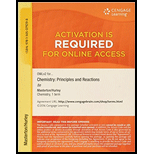
The decomposition of nitrogen dioxide is a second-order reaction. At 550 K, a 0.250 M sample decomposes at the rate of 1.17 mol/L
min.
(a) Write the rate expression.
(b) What is the rate constant at 550 K?
(c) What is the rate of decomposition when
(a)
Interpretation:
To write the expression of rate from the given statement of a chemical reaction.
Concept introduction:
Rate of a chemical reaction: It tells us about the speed at which the reactants are converted into products.
Mathematically, rate of reaction is directly proportional to the product of concentration of each reactant raised to the power equal to their respective stoichiometric coefficients.
Let’s say we have a reaction:
Answer to Problem 19QAP
Expression of rate is:
Explanation of Solution
Nitrogen dioxide decomposes into nitrogen and oxygen gas as:
Since the order of reaction with respect to NO2 is second. Thus, rate law equation will look like:
(b)
Interpretation:
To determine the value of rate constant at 550 K.
Concept introduction:
Rate of a chemical reaction: It tells us about the speed at which the reactants are converted into products.
Mathematically, rate of reaction is directly proportional to the product of concentration of each reactant raised to the power equal to their respective stoichiometric coefficients.
Let’s say we have a reaction:
Answer to Problem 19QAP
Rate constant for given reaction,
Explanation of Solution
Nitrogen dioxide decomposes into nitrogen and oxygen gas as:
Since the order of reaction with respect to NO2 is second. Thus, rate law equation will look like:
Here we have:
Rate = 1.17 mol/L.min
[NO2 ] = 0.250 M
Plugging value of rate of reaction in equation 1 to get the value of rate constant as:
(c)
Interpretation:
To determine the value of rate of reaction when concentration of nitrogen dioxide is 0.800 M.
Concept Introduction:
Rate of a chemical reaction: It tells us about the speed at which the reactants are converted into products.
Mathematically, rate of reaction is directly proportional to the product of concentration of each reactant raised to the power equal to their respective stoichiometric coefficients.
Let’s say we have a reaction:
Answer to Problem 19QAP
Rate for given reaction when concentration of nitrogen dioxide is 0.800 M =11.981 M/min.
Explanation of Solution
Nitrogen dioxide decomposes into nitrogen and oxygen gas as:
Since the order of reaction with respect to NO2 is second. Thus, rate law equation will look like:
Here we have:
Rate constant= 18.72 L/mol.min
[NO2 ] = 0.800 M
Plugging value of rate of reaction in equation 1 to get the value of rate constant as:
Want to see more full solutions like this?
Chapter 11 Solutions
CHEMISTRY:PRIN.+REACTIONS-OWLV2 ACCESS
- Indicate the formula of the product obtained by reacting methyl 5-chloro-5-oxopentanoate with 1 mole of 4-penten-1-ylmagnesium bromide.arrow_forwardIn the two chair conformations of glucose, the most stable is the one with all the OH groups in the equatorial position. Is this correct?arrow_forwardIndicate the formula of the product obtained by reacting D-Galactose with hydroxylamine.arrow_forward
- helparrow_forwardThe temperature on a sample of pure X held at 1.25 atm and -54. °C is increased until the sample boils. The temperature is then held constant and the pressure is decreased by 0.42 atm. On the phase diagram below draw a path that shows this set of changes. pressure (atm) 2 0 0 200 400 temperature (K) Xarrow_forwardQUESTION: Answer Question 5: 'Calculating standard error of regression' STEP 1 by filling in all the empty green boxes *The values are all provided in the photo attached*arrow_forward
 Chemistry & Chemical ReactivityChemistryISBN:9781337399074Author:John C. Kotz, Paul M. Treichel, John Townsend, David TreichelPublisher:Cengage Learning
Chemistry & Chemical ReactivityChemistryISBN:9781337399074Author:John C. Kotz, Paul M. Treichel, John Townsend, David TreichelPublisher:Cengage Learning Chemistry & Chemical ReactivityChemistryISBN:9781133949640Author:John C. Kotz, Paul M. Treichel, John Townsend, David TreichelPublisher:Cengage Learning
Chemistry & Chemical ReactivityChemistryISBN:9781133949640Author:John C. Kotz, Paul M. Treichel, John Townsend, David TreichelPublisher:Cengage Learning ChemistryChemistryISBN:9781305957404Author:Steven S. Zumdahl, Susan A. Zumdahl, Donald J. DeCostePublisher:Cengage Learning
ChemistryChemistryISBN:9781305957404Author:Steven S. Zumdahl, Susan A. Zumdahl, Donald J. DeCostePublisher:Cengage Learning Chemistry: An Atoms First ApproachChemistryISBN:9781305079243Author:Steven S. Zumdahl, Susan A. ZumdahlPublisher:Cengage Learning
Chemistry: An Atoms First ApproachChemistryISBN:9781305079243Author:Steven S. Zumdahl, Susan A. ZumdahlPublisher:Cengage Learning
 Chemistry: The Molecular ScienceChemistryISBN:9781285199047Author:John W. Moore, Conrad L. StanitskiPublisher:Cengage Learning
Chemistry: The Molecular ScienceChemistryISBN:9781285199047Author:John W. Moore, Conrad L. StanitskiPublisher:Cengage Learning





